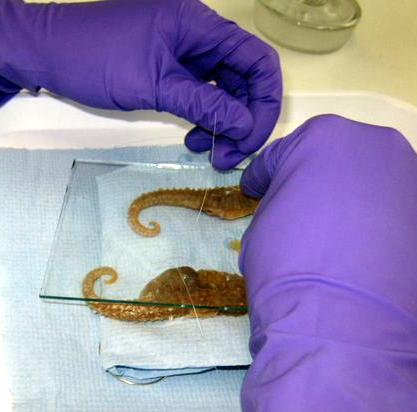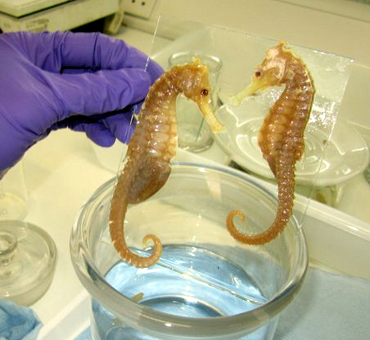This course is specifically aimed at those who have to manage and conserve natural history specimens preserved in fluids:
how to understand them, the chemical reactions that occur during the preservation process, what can go wrong and how to remedy many problems with them.
The course is largely practical with a lecture each day.
The course will take the usual four-day format and the cost will be £300 per person for
the four days and will cover all aspects of fluid preservation and conservation of fluid-preserved specimens.
The course comprises powerpoint presentations each day for about
1 hour and the rest of the day is entirely practical work.
Please contact Simon Moore to register for the course or if you require further information: couteaufin@btinternet.com
Terms.
Once attendance has been confirmed by e-mail, one third of the course fee will be payable in the event of a no-show or late cancellation.
Notice of cancellation can only be accepted 2 weeks prior to the commencement of the course. If a pro-forma invoice is required in advance please advise Simon Moore (couteaufin@btinternet.com).
Please advise Simon Moore of any personal allergies that you may have and also request a schedule if you require one in advance.
Due to dietary complications these days, lunches are not provided. A certificate of successful attendance will be issued following the course.
Full handouts (including risk assessments) are included in the cost but not accommodation. For notes on accommodation, see the bottom of this page.
Details of the course contents are below, but first here are some genuine unsolicited comments about Simon's fluid preservation courses:
 'I participated in Simon's fluid preservation course at the Horniman in November 2010 and
I personally encourage everyone who is interested in fluid preserved collections particularly those of you who work with old collections -
to take this workshop if you can. Simon is a terrific instructor and the Horniman facilities are excellent. You will learn a lot of very useful things.
A write-up about the course is due to appear in the upcoming SPNHC Newsletter'.
'I participated in Simon's fluid preservation course at the Horniman in November 2010 and
I personally encourage everyone who is interested in fluid preserved collections particularly those of you who work with old collections -
to take this workshop if you can. Simon is a terrific instructor and the Horniman facilities are excellent. You will learn a lot of very useful things.
A write-up about the course is due to appear in the upcoming SPNHC Newsletter'.
John Simmons of Museologica, Pennsylvania, USA.
'As with others, we have benefited from Simon’s course. We hosted one in Dublin, which like the US means that he can’t fly carrying some of the interesting chemicals and tools that are needed. But you need to get these in you museum anyway so it’s a good idea to get your shopping list from Simon and stock up in advance. We included university technicians from zoology and anatomy departments to get the numbers to make the course financially viable. We also included all in our small museum staff so that even if people don’t work with wet collections on a daily basis they understand fully what they are all about. I can also add my support to Simon’s long experience in museums and unparalleled knowledge in his field.'
Mr Nigel T. Monaghan, National Museum of Ireland.
I have been lucky to gain from Simon's broad expertise during the KUR-Programme and haven't met a person being that much devoted to fluid preservation, collection care and restoration of historic collection objects before. His broad practical knowledge can hardly be pressed into the few lines of a publication, and even though we didn't manage to bring Simon and his course to Germany yet, I can only encourage folks dealing with fluid collections to gain from Simon's expertise. Being a freelancer he has to take money for the course, but this is well invested money, especially regarding (historic & modern) preservation techniques. Book him, his course surely is worth every penny!”
Dirk Neumann, The Bavarian State Collection of Zoology, Munich (ZSM).
 10.00 start. Introduction: including local logistics, fire-exits, risks, allergies, house H&S rules, self introductions.
10.00 start. Introduction: including local logistics, fire-exits, risks, allergies, house H&S rules, self introductions.Power-point 1: overview of course technology and histological effects of fluid preservation.
Questions and tea-break, discussion about the importance of fluid collections, fixation versus pseudo-fixation, fixation versus preservation.
Glass cutting, grinding, drilling (demonstration & practical): necessary for making lids and backing plates.
Rehydration of dried-out specimens started (d & p)
Relevance of injecting fresh material with fixative
13.00 - 14.00. Lunch (not provided – either bring your own or use local facilities.
Preparation of jars (checking, grinding out blemishes – d & p)
Dehydration/ Hydration ladders start (d & p)
Thread mounting of specimens (d & p).
Celloidin mounting of snails to specimens and labels (d & p)
- 17.00 Check rehydrating specimens and fix + inject if they are ready, else leave (unheated) overnight (d & p).
Day 2.
 09.00 start. Power-point 2: narcotisation, historical sealants, pelagic (jellyfish) mounts, botanical preservatives.
09.00 start. Power-point 2: narcotisation, historical sealants, pelagic (jellyfish) mounts, botanical preservatives.Check of previous day’s work, analyse and correct problems. Move specimens in ladders (d & p)
Changing fluids in sealed jars (d & p).
How to deal with air bubbles, especially those trapped inside rehydrated specimens using a small portable vacuum pump: (d & p)
Making glass needles and their use in specimen repair (d & p)
Celloidin repair of specimens in IMS (or day 3: d & p)
Releasing vacuum in Visijars (talk if none available)
Thread mounting of specimens (continuation) including jellyfish on acetate discs (d & p).
13.00 – 14.00 Lunch (as before).
Move specimens in ladders (d & p)
Compounding of sealant/s (gelatine, Acrifix, bitumen)
Unsealing jars containing specimens requiring treatment (d & p)
Other types of sealants including historical sealants (d only)
- 17.00 Sealing of jars that are ready (d & p)
Day 3.
 09.00 start. Power-point 3: preservatives, lipids, copper wire staining
09.00 start. Power-point 3: preservatives, lipids, copper wire stainingChecking of previous day’s seals (d & p).
Assessing problems: evaporation and dilution
Dealing with lipids and other contaminants including fungal growth
Copper salts staining specimens, from being mounted on copper wire.
Detecting preserving fluids and auto-dilution problems: use of map pins and Dries van Dam’s ‘pills’ - Making your own specific gravity detector (d & p)
Which preservatives should you use? (On hand-outs)
Problems of mixing fluids (exothermic due to binary azeotropy and leading to air bubble formation).
Buffering and pH levels (d & p).
13.00 - 14.00. Lunch.
Stretching polypropylene rod (d & p)
– 17.00 Topping up sealed jars, ‘corking’ and sealing. Checking for problems and why they may have occurred.
Day 4.
 09.00 start.
09.00 start.Power-point 4: Transparencies, labels and label inks, tubes in jars (invert or not?) Jar types and problems, storage areas, plastination – ethics.
Check of nearly-finished jars, are they leaking? If so, why, what has caused this – understanding how and why problems can occur and why deadlines can be difficult to meet! (d & p).
Dealing with transparencies – clearing fluids including glycerol, propylene glycol, methyl benzoate and turpentine and problems associated with these.
Sending fluid-preserved specimens by post or courier, worldwide policies changing year to year. Links to answers nh-coll website: www.mailman.yale.edu/mailman/listinfo/nhcoll-l
How to store such collections so that they need minimum monitoring and maintenance.
Labels and their problems, which paper/s to use. Internal or external labels?
13.00 - 14.00. Lunch.
Finishing of practical work and projects, then16.00 – Packing up & Depart.
Location of the course: See map below.

(written by Dr Thomas Hartman. Email: Thomas.Hartman@nottingham.ac.uk)
The university has its own hotel, but it is not a cheap one. I would suggest that you look for an Air B&B along the tram route (I’d go towards Beeston/Chilwell) which is a very short tram ride away.
I would suggest that we use Lakeside Arts Centre for coffee and meeting up as they are hugely supportive of the university collections.
I know the café owner and the outreach staff there and they would put out a table for us if you wanted to have a meet and greet session before getting into the labs.
We can chat about organising something for one evening too so as to get a support group together.
It would probably be best if I give everyone a quick tour of what is where when they arrive.
Please contact me (Tom) if you’re driving and need somewhere to park.

With thanks to John Simmons for the images.
An article from a recent SPNHC (Society for the Preservation of Natural History Collections) Newsletter about this course:

